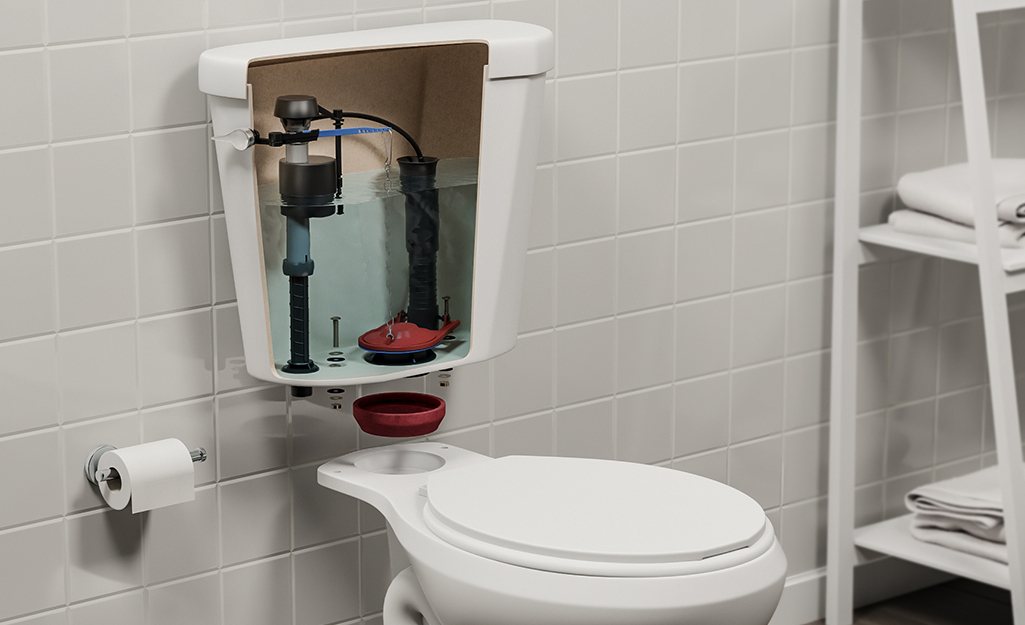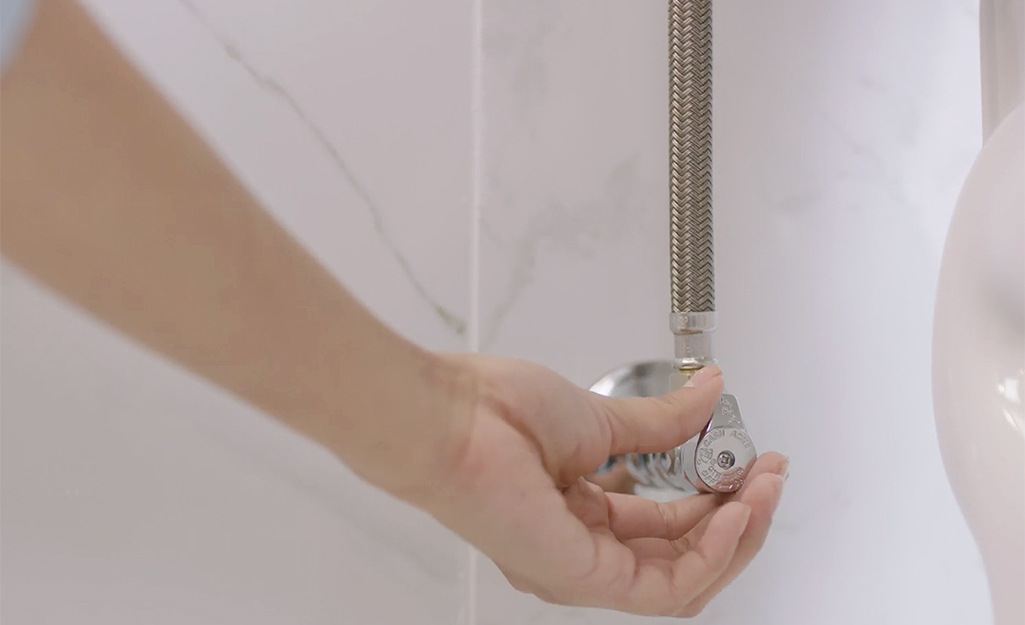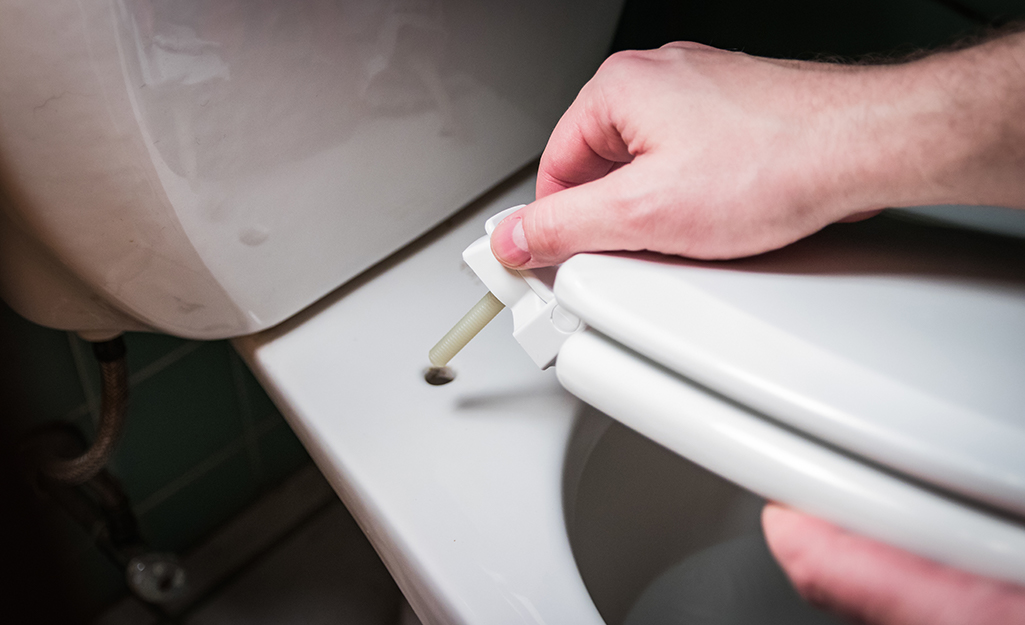How does the toilet work

Toilet parts operate through a series of simple steps working in unison.
- The user depresses the flush handle.
- The toilet handle is attached to an arm inside the toilet tank, which raises a flapper.
- The raised toilet flapper releases water from the tank into the toilet bowl.
- The water flushes the waste through the toilet bowl’s trap and into the drain and sewer lines.
- As the water level decreases in the tank, the float drops, opening the fill valve.
- Water returns to the tank through the fill valve.
- The water level rises until the rising float reaches the point that closes the fill valve.
Before you begin

Before you begin troubleshooting common toilet problems, take the following steps.
- Inspect the area where you’ll be working to identify the toilet problem.
- Have a bucket or towels on hand to catch or wipe up the water.
- Frequently when working with plumbing parts and repair matters, you’ll need to turn off the water supply valve and flush the toilet to empty the tank.
- Disconnect the supply line from the tank. If necessary, sponge the inside of the tank until dry.
Tip: Have our number handy if you discover your toilet has a bigger problem than a simple fix can address.
Toilet won't stop running

If your toilet won’t stop running or is noisy when not in use, you may need to adjust or replace the toilet fill valve. A constantly running toilet may be due to the tank water level being too high, which causes water to flow over the top of the overflow tube and into the tank.
- To adjust, bend the float arm down until the float reaches the level that shuts off the water. It may require some trial and error to find the correct level.
- Alternatively, the flapper may be out of place or failing to create a seal in the opening of the flush valve. A worn-out flapper will cause water to constantly trickle from the tank to the bowl. Remove the flapper by disconnecting the flapper chain from the flush handle lever. Slide the flapper off the pegs that extend from the sides of the flush valve tube. Attach the new flapper by hooking each ear of the flapper onto the pegs and connecting the flapper chain to the lever.
- Turn on the water and flush the toilet to test the flapper.
- A faulty toilet flapper or flush valve can also lead to a “phantom flush,” when a toilet seems to flush without having a handle pressed. You may need to replace a flapper or the entire flush valve.
Low Pressure in the Toilet

There are several possible reasons for a low water level in a toilet bowl.
- The toilet tank fill tube may be damaged or incorrectly positioned, preventing the water level from reaching its proper level.
- Position the fill tube so water is flowing into the overflow tube (the open pipe near the center of the tank). If this doesn’t fix the problem, replace the fill tube.
- When learning how to adjust the water level in the toilet bowl, check whether the toilet has a mark on the inside of the tank that indicates the proper water level. It should be 1 to 2 inches below the fill valve and the overflow tube.
- Often you can set the water level by adjusting the float. Toilets with ball floats and arms usually have adjustment screws or dials to raise or lower the arm. If your toilet mechanism has a cylinder float, squeeze the float clip to release the float so you can slide it up or down to the correct level.
- In addition, if the toilet tank is not flushing all the way, it may be because the bowl’s inlet holes are clogged, preventing enough water from entering the bowl from the tank. Use a mirror to inspect the inlet holes, just under the lip of the toilet bowl. If they’re clogged, pour hot vinegar into the overflow tube. Let it sit at least an hour (overnight if possible) and then use a piece of wire to clean out the inlet holes. Then flush to see if the holes are clear of debris.
- If these don’t work, inspect the bowl itself. If you find a crack, you’ll need to remove and replace the toilet bowl.
No water in the toilet tank

If there’s no water in the toilet tank, make sure the water supply valve is fully turned to the open position and check the water supply line for leaks.
- Make sure there’s no problem with the water supply to the bathroom or the rest of the house.
- If the water level in the toilet tank is too low, the float arm may be working improperly and need adjustment as described in Step 4.
- If the adjustment doesn’t help, replace the fill valve. Detach the nut that connects the water supply line to the valve and the second nut that connects the valve to the tank. The fill valve and attached float should lift out of the tank. Put the replacement fill valve in place and attach it to the tank, then attach the water supply line. Turn on the water and test.
Toilet is leaking

There are multiple places where a toilet may leak, usually if one of the seals or other components is damaged or needs replacement.
- For leaks at the water supply, check the water supply valve at the wall and the water supply line. Make sure everything is attached tightly, but do not overtighten.
- If the flapper is leaking, replace the flapper or valve as described in Step 3.
- If the toilet is leaking where the tank meets the bowl, the bolts and gasket between the tank and bowl may need to be replaced.
- If water is leaking from the base of the toilet, it may be from the wax ring that seals the toilet flange to the drain opening in the floor. To replace the wax ring, you’ll need to remove the toilet entirely!
Stuck or Loose Toilet Handle

A stuck or loose toilet handle may prevent a toilet from flushing, require multiple attempts to flush properly, or require holding the handle down to flush fully.
- First, use an adjustable wrench to adjust the nut inside the toilet. Loosen the nut if the handle is stuck or tighten the nut if the handle is loose.
- If the handle remains loose, the lift chain that connects to the lift arm may need to be adjusted. Take up excess slack in the chain by reconnecting it to a different hole in the handle lever or hooking it onto different links. The lift chain should hang straight from the handle lever with about 1/2 inch of slack.
- If the toilet handle is broken, you’ll need to replace it. Remove the old handle by detaching the lift chain, removing the handle mounting nut, and slipping the arm out through the hole in the tank.
- Install the new handle by slipping the arm through the hole, attaching the handle mounting nut, and attaching the lift chain. Then turn the water back on and see if the new handle flushes properly.
Toilet Clogged or Overflowing

Many problems with clogged or overflowing toilets can be fixed with a plunger, plumber’s auger, or chemical drain opener.
- When using a plunger, make sure the toilet bowl contains enough water to submerge the head of the plunger. Place the plunger over the hole in the toilet bowl, maintain a seal and plunge up and down rapidly, keeping the plunger under the water level. Be prepared for multiple plunge cycles or dozens of plunges per cycle. Flush to see if the clog has cleared. If not, repeat.
- If plunging does not clear the clog, try a plumbing snake or auger. Feed the end of the cable into the toilet as far as it will go. Turn the handle clockwise and push until you either snag or loosen the obstruction and remove it.
- If an auger does not work, try a chemical drain opener according to the instructions. Use caution, as chemical drain cleaners can have corrosive properties.
- If none of these methods work, contact a plumber.
Toilet Seat is Cracked or Loose

If the toilet seat is wobbly, the bolts may just be loose and in need of tightening, which is a quick fix. Simply check the bolts for looseness and use an adjustable wrench to tighten them as needed.
- If the toilet seat is cracked or otherwise broken, it will need to be replaced. Pry back the bolt caps and use an adjustable wrench to remove the bolts.
- Lift the old seat and its hinges from the toilet.
- Unpack the new seat and feed its bolts through the holes in the hinges and into the matching holes on the toilet bowl.
- Attach the nuts to the other ends of the bolts, tighten by hand, and then with an adjustable wrench.
- Jiggle the seat to make sure it fits firmly and evenly. Adjust as needed.
Many common toilet problems you can easily fix with such must-have plumbing tools as adjustable wrenches. If the toilet tank is not filling, the toilet tank is not flushing all the way or the toilet is having other issues, you can often identify and remedy them with relatively simple steps. For more complicated toilet issues, call a professional toilet repair contractor.


